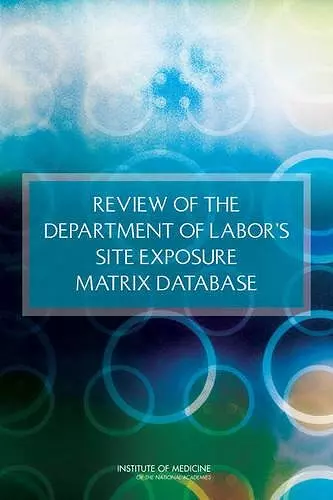Review of the Department of Labor's Site Exposure Matrix Database
Institute of Medicine author Board on the Health of Select Populations author Committee on the Review of the Department of Labor's Site Exposure Matrix Database author
Format:Paperback
Publisher:National Academies Press
Published:14th Apr '13
Currently unavailable, and unfortunately no date known when it will be back

Beginning with the development of the atomic bomb during World War II, the United States continued to build nuclear weapons throughout the Cold War. Thousands of people mined and milled uranium, conducted research on nuclear warfare, or worked in nuclear munitions factories around the country from the 1940s through the 1980s. Such work continues today, albeit to a smaller extent. The Department of Energy (DOE) is now responsible for overseeing those sites and facilities, many of which were, and continue to be, run by government contractors. The materials used at those sites were varied and ranged from the benign to the toxic and highly radioactive. Workers at DOE facilities often did not know the identity of the materials with which they worked and often were unaware of health risks related to their use. In many instances, the work was considered top secret, and employees were cautioned not to reveal any work-related information to family or others. Workers could be exposed to both radioactive and nonradioactive toxic substances for weeks or even years. Consequently, some of the workers have developed health problems and continue to have concerns about potential health effects of their exposures to occupational hazards during their employment in the nuclear weapons industry.
In response to the concerns expressed by workers and their representatives, DOL asked the Institute of Medicine (IOM) to review the SEM database and its use of a particular database, Haz-Map, as the source of its toxic substance-occupational disease links. Accordingly, this IOM consensus report reflects careful consideration of its charge by the committee, and describes the strengths and shortcomings of both. To complete its task, IOM formed an ad hoc committee of experts in occupational medicine, toxicology, epidemiology, industrial hygiene, public health, and biostatistics to conduct an 18-month study to review the scientific rigor of the SEM database. The committee held two public meetings at which it heard from DOL Division of Energy Employee Occupational Illness Compensation (DEEOIC) representatives, the DOL contractor that developed the SEM database, the developer of the Haz-Map database, DOE worker advocacy groups, and several individual workers. The committee also submitted written questions to DOL to seek clarification of specific issues and received written responses from DEEOIC. The committee's report considers both the strengths and weaknesses...
ISBN: 9780309268691
Dimensions: unknown
Weight: unknown
134 pages